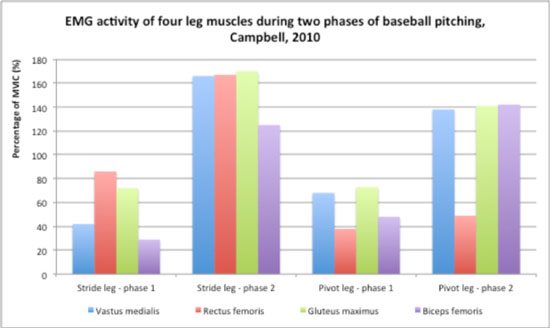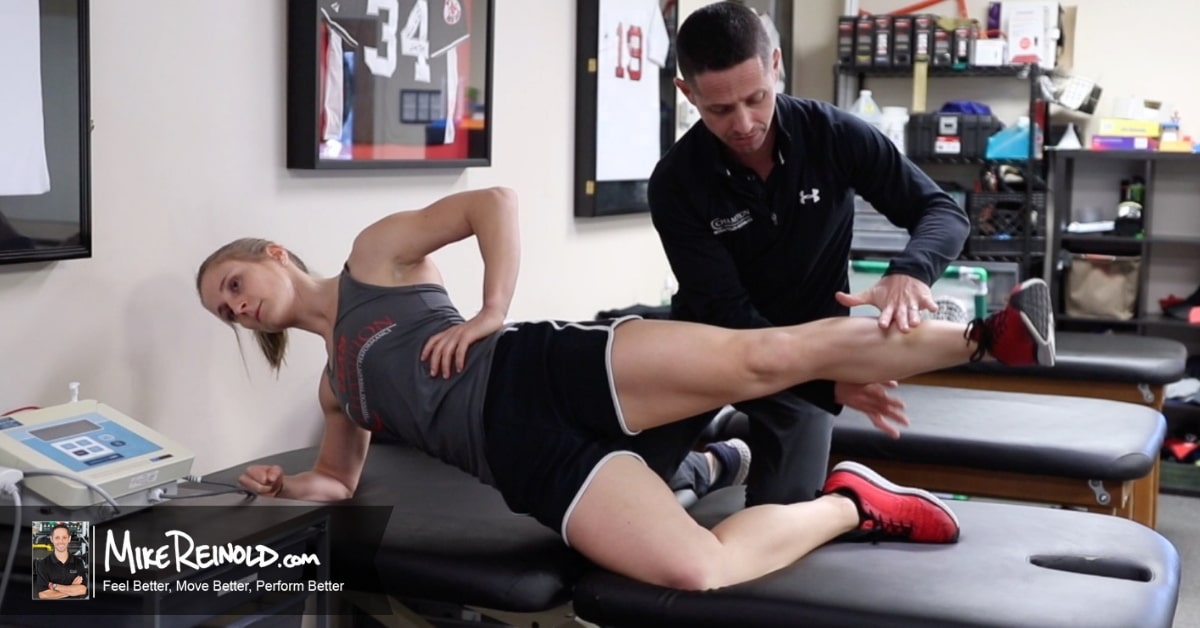Baseball pitching appears to the general public to be mainly an upper-body movement. However, researchers have found that like many rotational movements such as golf swings and tennis serves, it involves the lower body and trunk musculature extensively. In fact, according to a theory known as proximal-to-distal sequencing, the pitching motion is actually initiated by the lower body and progresses through the core before accelerating the arm and finally the hand.
What is proximal-to-distal kinematic sequencing?
Researchers have suggested that rotational movements such as the baseball, golf or tennis swing follow proximal-to-distal kinematic sequence. Proximal to distal kinematic sequencing is where a motion is initiated by the larger, central body segments and then proceeds outward to the smaller, more distal segments, such as the arms.
While the concept is relatively clear, the terminology varies. Callaway (2012) has noted that researchers have referred to proximal to distal sequencing as kinetic linking or the kinematic sequence and in a recent article, Spaniol (2012) referred to the same principle as “sequential kinetic linking.”
In any event, where optimal proximal-to-distal kinematic sequencing occurs in sport, the pelvis is rotated using the leg and hip muscles. The pelvis accelerates but then quickly decelerates as it transfers energy to the torso. The same pattern is repeated with the torso and the arm and then the arm and the hand, club, bat or racket. Where the kinematic sequence is out-of-order, it is thought that energy is lost, performance decreases and other body segments step in to compensate, which can lead to injury.
What do we know about the role of the lower body in baseball pitching?
While the principle of proximal-to-distal kinematic sequencing indicates that there is a sound theoretical basis for the role of the lower body in baseball pitching, few studies have actually investigated either the forces or the muscle activity involved.
In fact, there are only four studies regularly referenced when discussing the role of the lower body muscles in baseball pitching: MacWilliams (1998), Yamanouchi (1998), Campbell (2010) and Oliver (2010). The studies by MacWilliams and Oliver investigated aspects of proximal-to-distal kinematic sequencing that are seen in baseball pitching, while the studies by Campbell and Yamanouchi looked more generally at the involvement of the leg musculature.
What does the research say about proximal-to-distal kinematic sequencing in pitching?
Is leg drive correlated with wrist velocity?
MacWilliams (1998) investigated the full-body kinematics and kinetics of 7 baseball pitchers using force plates to record leg drive and a five-camera motion analysis system for recording the joint angle movements. Most significantly, they found that wrist velocity correlated significantly with leg drive.
[quote]Pitchers with greater leg drive produced greater wrist velocities.[/quote]
The researchers therefore concluded that the lower body has an important role in increasing the speed of the throwing motion and supports the use of the proximal-to-distal kinematic sequencing model in any biomechanical analysis of baseball pitching. They therefore proposed that strengthening the lower body is important for enhancing pitching performance and avoiding injury.
Are the gluteals correlated with torso rotation during pitching?
Oliver (2010) investigated the muscle activity of the gluteals and explored the relationship of the gluteals to pelvis and torso kinematics during baseball pitching. The researchers found that the activity of the gluteus maximus was directly related to the rate of axial pelvis rotation and also that it was indirectly related to the rate of axial torso rotation.
[quote]Greater gluteus maximus activity increases rotational speed[/quote]
This study therefore also supports the use of the proximal-to-distal kinematic sequencing model in any biomechanical analysis of baseball pitching. Additionally, it implies that training the gluteals should be a specific focus of baseball pitchers. Optimal exercises for the gluteus maximus include the squats, trap bar deadlifts, hip thrusts, and back raises. However, the gluteus maximus can and should be strengthened in the transverse plane via core rotational movements such as the band hip rotation. See Mike’s article on training the glutes in multiple planes of motion.
What does the research say about leg muscle activity in pitching?
Are the adductors active during pitching?
Yamanouchi (1998) investigated the muscle activity of various upper and lower body muscles during a baseball pitch performed by 10 baseball players and 10 untrained subjects. He used surface electrodes to measure the electromyographical (EMG) activity and normalized the signal against a maximum voluntary isometric contraction (MVIC). He separated the baseball pitching movement into just two phases divided by the point at which the non-pivoting leg landed. The activity of the thigh muscles reported by Yamanouchi is shown in the chart below. Unfortunately, he did not record the activity of the gluteals or hamstrings.
Yamanouchi concluded that his findings were consistent with reports that pitching can lead to problems with the adductor muscle group. He therefore suggested that strengthening the adductor and the antagonist abductor groups could therefore be useful for enhancing pitching performance and avoiding injury.
Most leg muscles are very active during pitching
Campbell (2010) investigated the muscle activity of the biceps femoris, rectus femoris, gluteus maximus, vastus medialis and gastrocnemius during the baseball pitching motion. The researchers used surface electrodes to measure the EMG activity in 11 highly skilled baseball pitchers and normalized the data against MVICs. Rather than the two-phase division used by Yamanouchi, they divided the pitching action into four phases, although the data can be restated to be comparable with the two phases used by Yamanouchi, as shown in the chart below.
The researchers concluded that muscle activity in both the stride and pivot legs reached extremely high levels during the baseball pitch and was generally very high throughout. They therefore suggested that since pitchers must perform over 100 pitches per game, this implies that pitchers need a high level of maximal strength/power as well as a high degree of muscular endurance. They therefore recommend training the lower body of baseball pitchers to increase strength, explosive power and muscular endurance.
What can we conclude?
From this admittedly small body of research, we can suggest that:
- Proximal-to-distal kinematic sequencing seems to occur during baseball pitching, with the movement being initiated by the legs, transferred through the pelvis to the torso, through the arm and finally into the hand.
- Leg drive is therefore important for pitching velocity. Improving the strength and power of the legs should consequently transfer to faster pitching performance.
- Since pitchers may have to perform approximately 100 pitches per game, some degree of muscular endurance training for the legs could be beneficial.
- While all leg muscles are very involved in the pitching action, the activity of the gluteals is strongly correlated with pelvic axial rotation velocity, suggesting that specific gluteal training may be worthwhile. A variety of gluteal exercises from multiple vectors is needed for optimal performance.
- The adductors may be more involved in the pitching movement than in most standard resistance-training exercises, suggesting that specific exercises should be used to focus on these muscles to help improve performance and avoid injury.
Mike’s Thoughts
Chris wrote an outstanding article as usual. Obviously, as you can see, the leg strength and power is pretty important to baseball pitching. The concept of the proximal to distal kinetic chain sequencing is likely one of the many important factors involved with baseball pitching. Why is it that some of the brightest people in the world can flawlessly understand baseball pitching biomechanics yet can’t pitch successfully! Heck, I am one of the guilty! It’s not that I do not understand how to throw, it’s that I have an imperfect sequence of events that result in a less than ideal fastball! So, while leg strength and power are important to baseball pitching, we can’t forget about training this sequence. This is why proper coaching at a young age and proper strength and conditioning programs that understand this concept are necessary.
In regard to our training programs, these studies demonstrate the need to emphasize the legs, and should give guidance on what specific muscles to focus on. Chris states it well, however, I will further reinforce his comments that we need to train the legs, but also focus on leg work outside of the sagittal plane.
About the author

[hr]






